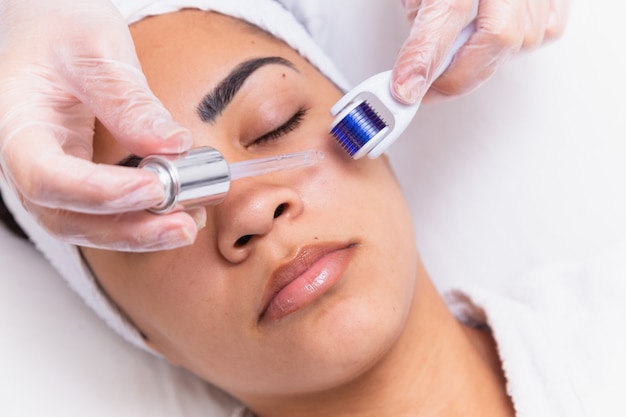In the ever-evolving world of skincare, two terms have emerged at the forefront of discussion: microneedling and dermarolling. Though they may seem synonymous at first glance, these techniques diverge in their methods, benefits, and safety profiles, leaving many to ponder which path is best for achieving that coveted flawless complexion.
Microneedling, often performed in clinical settings, employs specialized devices to create precise micro-injuries that invite the skin to rejuvenate itself. In contrast, dermarolling, a more accessible at-home option, uses handheld rollers adorned with fine needles to stimulate the skin.
But as interest in these treatments surges, questions loom: Are they truly safe? How do their effects differ? Let’s unravel the distinctions between microneedling and dermarolling, helping you navigate the intricate landscape of skin rejuvenation with confidence.
Understanding Microneedling: Procedure and Benefits

Microneedling, also known as collagen induction therapy, is a minimally invasive procedure that involves the use of tiny needles to create controlled micro-injuries in the skin. This process stimulates the body’s natural healing response, promoting collagen and elastin production, which can lead to smoother, firmer skin.
The procedure usually takes about 30 minutes and can be comfortably performed with the use of topical anesthetics. Patients often report noticeable improvements in skin texture, reduced appearance of scars, and diminished fine lines after just a few sessions.
Furthermore, microneedling can enhance the absorption of topical treatments, making it an effective solution for issues like hyperpigmentation or acne. While some redness and swelling may occur post-treatment, these side effects typically subside within a couple of days, leaving patients with rejuvenated skin and a newfound confidence that makes the procedure alluring for many seeking a youthful glow.
Exploring Dermarolling: Procedure and Benefits
Exploring dermarolling unveils a fascinating blend of simplicity and effectiveness in skincare. The procedure involves a handheld device adorned with fine needles that creates micro-injuries on the skins surface, prompting an intense healing response.
This stimulates collagen production, enhancing skin texture and reducing the appearance of scars, fine lines, and large pores. The appeal of dermarolling lies not only in its potential to rejuvenate but also in its accessibility; individuals can perform it at home with the right tools and guidance.
Yet, proficiency is crucial—too much pressure or incorrect technique can lead to irritation or damage. As a result, many find that the benefits of dermarolling extend beyond just aesthetics, as it fosters a sense of empowerment in ones skincare routine, promoting healthier, more radiant skin while encouraging a holistic approach to personal care.
Key Differences Between Microneedling and Dermarolling

Microneedling and dermarolling, while similar in their goal of rejuvenating the skin, have several distinct differences that set them apart. Microneedling is typically performed in a professional setting using a motorized device equipped with fine, sterile needles, allowing for precise control over depth and speed.
This method promotes effective collagen production and is often tailored to the individuals skin type and concerns. On the other hand, dermarolling involves a handheld tool with a roller covered in needles, which users can apply at home.
While this method is more accessible and cost-effective, it may not achieve the same level of precision or results found in professional treatments. Additionally, the needles in dermarollers are often shorter, leading to a more superficial treatment that could limit its efficacy for deeper skin issues.
Choosing between these two options largely depends on ones skincare needs and the desired outcomes, alongside considerations of safety and expertise.
Conclusion
In conclusion, while both microneedling and dermarolling serve the purpose of enhancing skin texture and promoting collagen production, their techniques and results can vary significantly. Microneedling is often performed in professional settings with advanced devices that ensure precision and safety, making it a preferred choice for those seeking more dramatic results.
On the other hand, dermarolling offers a convenient at-home option but requires a careful approach to minimize potential risks. Ultimately, individuals should assess their skin concerns and consult with skincare professionals to determine the best option for their needs.
For those interested in exploring these treatments further, reputable sources like spbeauty.co.uk can provide valuable insights and guidance on the right path to healthier, rejuvenated skin.


